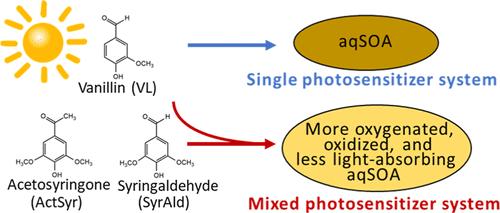当前位置:
X-MOL 学术
›
Environ. Sci. Technol.
›
论文详情
Our official English website, www.x-mol.net, welcomes your feedback! (Note: you will need to create a separate account there.)
Aqueous-Phase Photoreactions of Mixed Aromatic Carbonyl Photosensitizers Yield More Oxygenated, Oxidized, and less Light-Absorbing Secondary Organic Aerosol (SOA) than Single Systems
Environmental Science & Technology ( IF 11.4 ) Pub Date : 2024-04-23 , DOI: 10.1021/acs.est.3c10199 Beatrix Rosette Go Mabato 1 , Yong Jie Li 2 , Dan Dan Huang 3 , Chak K. Chan 1, 4
Environmental Science & Technology ( IF 11.4 ) Pub Date : 2024-04-23 , DOI: 10.1021/acs.est.3c10199 Beatrix Rosette Go Mabato 1 , Yong Jie Li 2 , Dan Dan Huang 3 , Chak K. Chan 1, 4
Affiliation

|
Aromatic carbonyls have been mainly probed as photosensitizers for aqueous secondary organic aerosol (aqSOA) and light-absorbing organic aerosol (i.e., brown carbon or BrC) formation, but due to their organic nature, they can also undergo oxidation to form aqSOA and BrC. However, photochemical transformations of aromatic carbonyl photosensitizers, particularly in multicomponent systems, are understudied. This study explored aqSOA formation from the irradiation of aromatic carbonyl photosensitizers in mixed and single systems under cloud/fog conditions. Mixed systems consisting of phenolic carbonyls only (VL + ActSyr + SyrAld: vanillin [VL] + acetosyringone [ActSyr] + syringaldehyde [SyrAld]) and another composed of both nonphenolic and phenolic carbonyls (DMB + ActSyr + SyrAld: 3,4-dimethoxybenzaldehyde [DMB], a nonphenolic carbonyl, + ActSyr + SyrAld) were compared to single systems of VL (VL*) and DMB (DMB*), respectively. In mixed systems, the shorter lifetimes of VL and DMB indicate their diminished capacity to trigger the oxidation of other organic compounds (e.g., guaiacol [GUA], a noncarbonyl phenol). In contrast to the slow decay and minimal photoenhancement for DMB*, the rapid photodegradation and significant photoenhancement for VL* indicate efficient direct photosensitized oxidation (i.e., self-photosensitization). Relative to single systems, the increased oxidant availability promoted functionalization in VL + ActSyr + SyrAld and accelerated the conversion of early generation aqSOA in DMB + ActSyr + SyrAld. Moreover, the increased availability of oxidizable substrates countered by stronger oxidative capacity limited the contribution of mixed systems to aqSOA light absorption. This suggests a weaker radiative effect of BrC from mixed photosensitizer systems than BrC from single photosensitizer systems. Furthermore, more oxygenated and oxidized aqSOA was observed with increasing complexity of the reaction systems (e.g., VL* < VL + ActSyr + SyrAld < VL + ActSyr + SyrAld + GUA). This work offers new insights into aqSOA formation by emphasizing the dual role of organic photosensitizers as oxidant sources and oxidizable substrates.
中文翻译:

混合芳族羰基光敏剂的水相光反应比单一系统产生更多的氧化、氧化和吸光更少的二次有机气溶胶 (SOA)
芳香族羰基化合物主要作为光敏剂用于水性二次有机气溶胶(aqSOA)和光吸收有机气溶胶(即棕碳或BrC)的形成,但由于其有机性质,它们也可以氧化形成aqSOA和BrC。然而,芳香族羰基光敏剂的光化学转化,特别是在多组分体系中,尚未得到充分研究。本研究探讨了云/雾条件下混合和单一系统中芳香族羰基光敏剂的辐照形成 aqSOA。仅由酚类羰基化合物组成的混合体系(VL + ActSyr + SyrAld:香草醛 [VL] + 乙酰丁香酮 [ActSyr] + 丁香醛 [SyrAld])和另一种由非酚类和酚类羰基化合物组成的混合体系(DMB + ActSyr + SyrAld:3,4-二甲氧基苯甲醛) [DMB],一种非酚羰基,+ ActSyr + SyrAld)分别与 VL (VL*) 和 DMB (DMB*) 的单一系统进行比较。在混合系统中,VL 和 DMB 的寿命较短,表明它们触发其他有机化合物(例如愈创木酚 [GUA],一种非羰基苯酚)氧化的能力减弱。与 DMB* 的缓慢衰减和最小的光增强相反,VL* 的快速光降解和显着的光增强表明有效的直接光敏氧化(即自光敏化)。相对于单一系统,氧化剂可用性的增加促进了 VL + ActSyr + SyrAld 中的功能化,并加速了 DMB + ActSyr + SyrAld 中早期一代 aqSOA 的转化。此外,可氧化底物可用性的增加与更强的氧化能力相抗衡,限制了混合系统对 aqSOA 光吸收的贡献。这表明来自混合光敏剂系统的 BrC 的辐射效应比来自单一光敏剂系统的 BrC 的辐射效应更弱。此外,随着反应系统复杂性的增加,观察到更多氧化和氧化的aqSOA(例如,VL* < VL + ActSyr + SyrAld < VL + ActSyr + SyrAld + GUA)。这项工作通过强调有机光敏剂作为氧化剂源和可氧化底物的双重作用,为 aqSOA 的形成提供了新的见解。
更新日期:2024-04-24
中文翻译:

混合芳族羰基光敏剂的水相光反应比单一系统产生更多的氧化、氧化和吸光更少的二次有机气溶胶 (SOA)
芳香族羰基化合物主要作为光敏剂用于水性二次有机气溶胶(aqSOA)和光吸收有机气溶胶(即棕碳或BrC)的形成,但由于其有机性质,它们也可以氧化形成aqSOA和BrC。然而,芳香族羰基光敏剂的光化学转化,特别是在多组分体系中,尚未得到充分研究。本研究探讨了云/雾条件下混合和单一系统中芳香族羰基光敏剂的辐照形成 aqSOA。仅由酚类羰基化合物组成的混合体系(VL + ActSyr + SyrAld:香草醛 [VL] + 乙酰丁香酮 [ActSyr] + 丁香醛 [SyrAld])和另一种由非酚类和酚类羰基化合物组成的混合体系(DMB + ActSyr + SyrAld:3,4-二甲氧基苯甲醛) [DMB],一种非酚羰基,+ ActSyr + SyrAld)分别与 VL (VL*) 和 DMB (DMB*) 的单一系统进行比较。在混合系统中,VL 和 DMB 的寿命较短,表明它们触发其他有机化合物(例如愈创木酚 [GUA],一种非羰基苯酚)氧化的能力减弱。与 DMB* 的缓慢衰减和最小的光增强相反,VL* 的快速光降解和显着的光增强表明有效的直接光敏氧化(即自光敏化)。相对于单一系统,氧化剂可用性的增加促进了 VL + ActSyr + SyrAld 中的功能化,并加速了 DMB + ActSyr + SyrAld 中早期一代 aqSOA 的转化。此外,可氧化底物可用性的增加与更强的氧化能力相抗衡,限制了混合系统对 aqSOA 光吸收的贡献。这表明来自混合光敏剂系统的 BrC 的辐射效应比来自单一光敏剂系统的 BrC 的辐射效应更弱。此外,随着反应系统复杂性的增加,观察到更多氧化和氧化的aqSOA(例如,VL* < VL + ActSyr + SyrAld < VL + ActSyr + SyrAld + GUA)。这项工作通过强调有机光敏剂作为氧化剂源和可氧化底物的双重作用,为 aqSOA 的形成提供了新的见解。



























 京公网安备 11010802027423号
京公网安备 11010802027423号